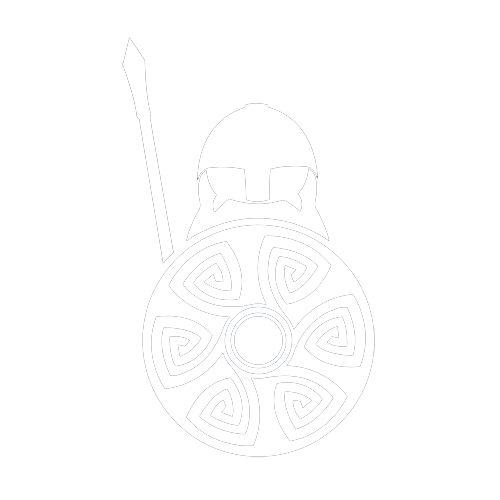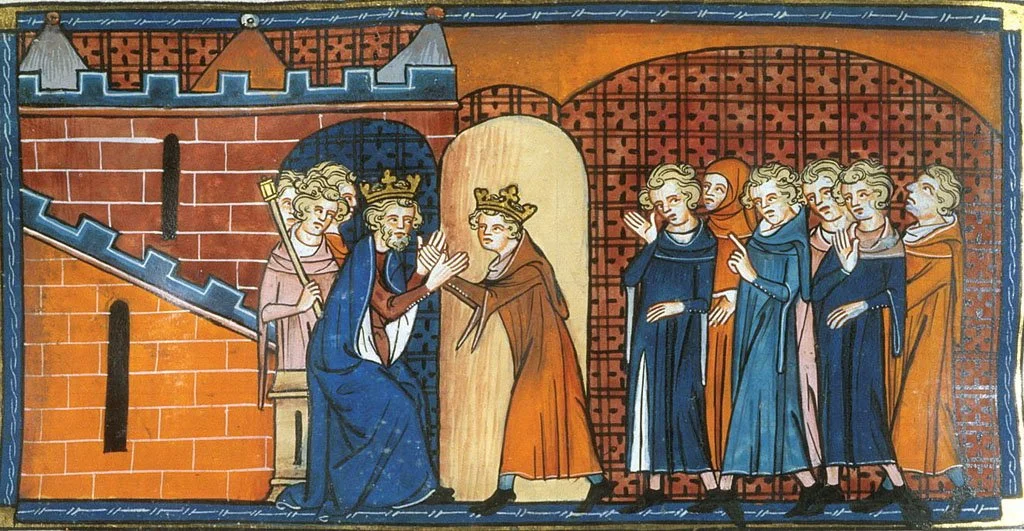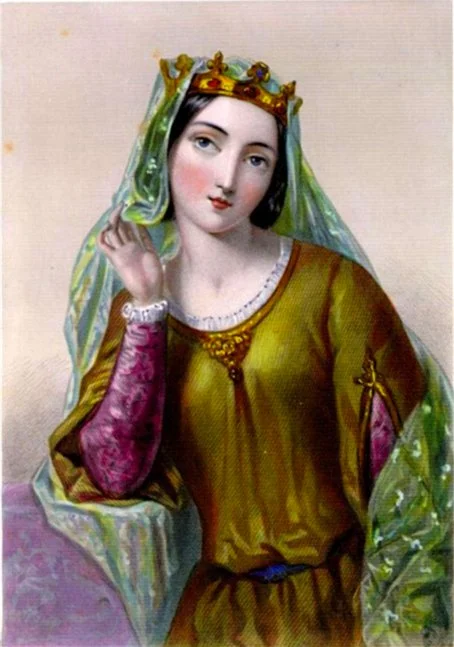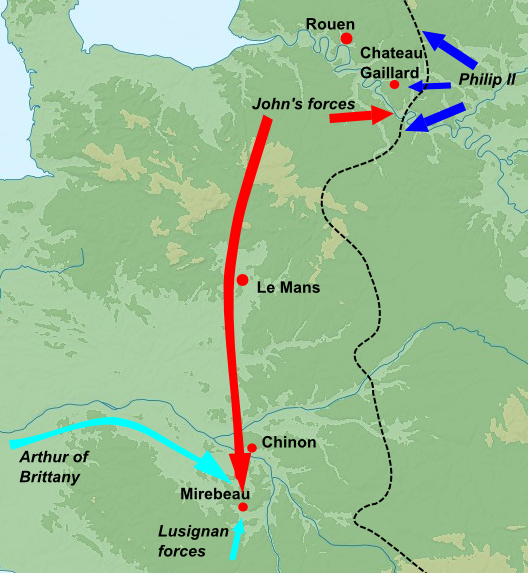King John the Tyrannical Ruler
King John was the fourth and youngest legitimate son of Henry II and Eleanor of Aquitaine. He was born on Christmas Eve 1166 at Beaumont Palace in Oxford, and was soon moved to the Abbey of Fontevrault in Anjou, to lead a life in the church. Even at this young age, John was petulant, unstable, spoilt and cruel. His red hair matched his red-faced fury, when he flew into a classic Plantagenet rage.
King John was known as Lackland, which was a nick-name jokingly given to him by his father. John did not receive any lands in his inheritance, which fuelled the nick-name. However, he did receive the title Lord of Ireland, in 1177. This epithet would later be reinforced during his reign, as King John would lose all his father's lands in France.
| Born | 24 December 1166, Oxford |
| Parents | Henry II and Eleanor of Aquitaine |
| Married | Isabella of Gloucester and Isabella of Angouleme |
| Children | 5, inc Henry III and a further 12 illegitimate children |
| Died | 18 October 1216, Newark Castle (49) |
| Reign | 1199 - 1216 (17) |
| Crowned | 27 May 1199, Westminster Abbey (32) |
| Predecessor | Richard I (brother) |
| Successor | Henry III (son) |
| House | Angevin |
Life Events of King John
1166
On 24 December, John is born in Oxford, England. He is the youngest son of King Henry II of England and Eleanor of Aquitaine.
1199
On 27 May, John is crowned King of England at Westminster Abbey, following the death of his brother, King Richard I.
1200
King John marries Isabella of Angoulême, a French noblewoman, in Bordeaux.
1204
King John loses most of his French territories, including Normandy, Anjou, and Poitou, to King Philip II of France.
1208
Pope Innocent III gets involved in a dispute over the appointment of the Archbishop of Canterbury. King John refuses to accept Stephen Langton as the Archbishop, resulting in England being placed under an interdict, which suspends religious services in the country.
1213
King John submits to Pope Innocent III and receives his forgiveness. He acknowledges the pope as his feudal lord and pays a large sum of money as a tribute.
1214
On 27 July, King John suffers a major defeat in the Battle of Bouvines against the combined forces of France, Flanders, and the Holy Roman Empire. This loss further weakens his position.
1215
On 15 June, King John is compelled by his discontented barons to sign the Magna Carta at Runnymede. The document outlines certain rights and privileges of the nobility, restricts the powers of the monarchy and establishes principles of justice and the rule of law.
1215
For the next year, King John faces ongoing rebellion from his barons who are dissatisfied with his rule. The rebels invite Prince Louis of France, the future Louis VIII, to claim the English throne, leading to a series of conflicts and battles.
1216
On 18 October, King John dies at Newark Castle in Nottinghamshire. His nine-year-old son, Henry III, succeeds him as King of England.
Interesting Facts About King John
Nickname
King John is often referred to as ‘Bad King John’ due to his troubled reign and the negative portrayal of his character in historical accounts. He was also known as John ‘Lackland’ because he was not expected to inherit significant lands. His last knickname was John ‘Softsword’ around 1200, which came about because he made peace with France. Some thought he should have fought harder for it.Robin Hood
While the legendary figure of Robin Hood is fictional, King John is depicted as his main adversary in the stories. This adds to the folklore surrounding King John and his unpopular image.Loss of the Crown Jewels
During King John's reign, he attempted to cross the Wash estuary, but his baggage train, including the Crown Jewels, was lost to the rising tide. The incident is said to have greatly upset him.Great Charter
King John's reign is most notably associated with the signing of the Magna Carta in 1215. Although he initially agreed to it under duress, the Magna Carta became a crucial document in the development of constitutional rights and limitations on royal power.Naval Innovations
King John made advancements in the English navy, increasing the number of ships and establishing the first royal dockyards. These efforts laid the foundation for the future expansion and strength of the English navy.Conflict with France
King John's loss of Normandy and other French territories was a significant blow to England's influence in continental Europe. This event marked a turning point in the relationship between England and France.Artistic Patronage
Despite his troubled reign, King John had an interest in the arts and was a patron of literature. He is known to have supported the works of several troubadours and poets.Reign
King John's reign lasted for 17 years, from 1199 until his death in 1216. Despite its difficulties, his reign had a lasting impact on England's legal and political history.
Battles Fought By King John
Battle of Mirebeau
On 1 August 1202, this battle took place during the early stages of King John's reign. He fought against his nephew, Arthur of Brittany, who had a claim to the English throne. The battle resulted in a victory for King John, securing his position as King of England.Battle of Bouvines
On 27 July 1214, although not fought directly by King John, this battle was a significant event during his reign. King John allied with Holy Roman Emperor Otto IV against the French King Philip II. The English forces were defeated, leading to John's loss of territories in France and his subsequent struggles with his barons.Siege of Rochester Castle
In October 1215, during the First Barons' War, a conflict between King John and rebellious barons, Rochester Castle was held by rebel forces. King John led a siege against the castle using siege weapons, which lasted for several months. They burned the fat from ‘40 pigs too fat to eat’ to ignite the timber props used to support the undermined masonry, the south-east corner of the keep collapsed, forcing the rebels to retreat to the northern half of the interior. Starvation soon forced the rebels’ surrender. Eventually, the castle fell to John's forces.
FAQs About the King
What is King John most famous for?
King John is most famous for his involvement in the signing of the Magna Carta in 1215. This document outlined rights and limitations on royal power, laying the foundation for constitutional principles in England.Why is King John often called ‘Bad King John’?
King John is often called ‘Bad King John’ due to his troubled reign and negative portrayal in historical accounts. He faced numerous challenges, including conflicts with his nobles and the loss of French territories. He was also a brutal and dishonourable tyrant, even allowing 22 knights to starve to death at Corfe Castle.What happened during King John's conflict with his barons?
King John faced a rebellion by his barons who were discontented with his rule. This conflict culminated in the signing of the Magna Carta, as the barons sought to limit the king's powers and protect their rights.Did King John lose territories in France?
Yes, during King John's reign, he lost significant territories in France, including Normandy, Anjou, and Poitou, to King Philip II of France in 1204.Did King John have any conflicts with the Church?
Yes, King John had several conflicts with the Church, most notably with Pope Innocent III over the appointment of the Archbishop of Canterbury. These conflicts resulted in England being placed under an interdict and strained relations with the papacy.
Further Reading
King John Accedes to the Throne
When King John received his Lord of Ireland title, Henry sent him to rule there in 1185. But John managed to offend the Irish nobles, through mockery and insults, and had to return just months later.
In 1192, his brother King Richard I was captured while away on Crusade, and John attempted to seize the English throne. The bishop of Ely, William Longchamp, was governing England on behalf of Richard at the time. However, Longchamp had alienated the English barons, and John saw his chance to overthrow the bishop.
This plot ultimately failed, and luckily for John, his brother Richard forgave him on his return from captivity. However, a few weeks later on Richard's deathbed, the king recognised John as his heir, with help from their mother, Eleanor of Aquitaine.
Eleanor would go on and secure the Angevin lands for King John, seeing off the rival claimant Arthur of Brittany, son of John's older deceased brother Geoffrey. Arthur's claim had support from Breton, Maine and Anjou nobles and also from King Phillip of France.
Arthur of Brittany paying homage to King Phillip of France
King John new he would have a fight on his hands to save his French territory. With Arthur and his allies preparing for an attack on Normandy, John had to defensively position his army along the southern borders, in preparation for battle.
King John Signs the Treaty of Le Goulet
Before the battle, the Counts of Flanders and Boulogne switched allegiances and renewed their anti-French alliances. These alliances were first formed back in Richard I's reign. This bolstered King John's position. Arthur and Phillip knew their advantage was now in the balance, and neither side wanted to engage in battle. King John and King Phillip decided to meet in May 1200 and sign the Treaty of Goulet, a truce.
The treaty stated that Phillip would recognise John as Richard's rightful heir to the lands in France, dismissing claims made by Arthur. In return, John would no longer use his alliance with Flanders and Boulogne against the French king. John would also accept Phillip's overlordship to his lands in France. This was a major blow to King John's reign. Back in England, the news spread, and John earned his second nick-name Softsword, in reference to his inability to fight off the French.
King John and Isabella of Angouleme
King John was married to the young Isabella of Gloucester prior to his accession. This was an arranged marriage by Henry II. The two were half-second cousins and great-grandchildren of Henry I.
The marriage had to be sanctioned by the pope, as they were close blood relations, which the pope granted. Shortly after King John was crowned in 1199, however, he obtained an annulment of the marriage, on the grounds of consanguinity. This allowed King John to marry Isabella of Angouleme a year later. They would go on to have 5 legitimate children, including the future heir Henry III.
Isabella of Angouleme was only 12 years old, and already betrothed to Hugh de Lusignan. However, this would not stop the lecherous King John, who in the past had been threatened for forcing himself upon noble wives and daughters.
Isabella was the beautiful daughter and heir of Aymer Taillefer, Count of Angoulême. King John was infatuated with her, and when he took Isabella for his wife in August 1200, the Lusignan family rebelled against him. John quickly crushed the rebellion, and the Lusignans fled to King Phillip of France for support.
The Battle of Mirebeau
Philip demanded John's appearance in court in Paris in 1202, to site the Treaty of Goulet. John refused, on the basis that he was Duke of Normandy, who did not need to attend a court of France. King Phillip, furious with the breach of feudal responsibilities, confiscated all of John's lands in France, handing them to Arthur of Brittany. The peace made by the Treaty of Goulet was now broken.
King Phillip and his allies Arthur and the Lusignan forces, once again set about attacked John's French territories. King John marshalled his troops in the only way he knew, with defensive positions protecting his key castles in Normandy. King Phillip attacked the eastern borders, while Arthur and the Lusignan forces marched from the south. This two-pronged attack sent John's defensive campaign into chaos.
Furthermore, while John's mother Eleanor was rallying support for John, Arthur discovered her location. He and his allies, who were advancing from the south, lay siege to Mirebeau castle where Eleanor was staying. Hearing of his mother's danger, King John reacted uncharacteristically, and advanced south with great haste, catching the siege by surprise. Had Eleanor been captured, the political repercussions would have been catastrophic for John.
King John's forces broke the siege, and he took Arthur and the rebel leaders captive. King Phillip had to withdraw his attack from Normandy's eastern borders, and advance south to the aid of Arthur.
The rebels demanded the release of Arthur, but King John bluntly refused. With this, the rebellions intensified, and John lost Angers and Tours and was forced to retreat north to Normandy.
The Death of Arthur of Brittany and 22 Knights
King John was now beginning to make his reputation as a wicked king apparent. His treatment of prisoners infuriated his allies. Most of the nobility were related in some way or another, and some of these nobles were his captives, disgracefully shackled in chains. Some of the most noble prisoners were sent over to England, as prisoner numbers grew too large in Normandy.
By 1203, King John's campaign in France was grim, while King Phillip's forces grew by the day. King John, was losing his grip on his French lands and costs were spiralling out of control. Not even the pope would intervene, when asked.
Arthur the prisoner was transferred to Rouen castle, where John tried to make peace with him. But defiant Arthur warned the king, that he would never make peace until his inheritance was reinstated. That is the last time anyone heard from Arthur. It was said that John murdered his own nephew in a rage.
King John then sent letters with his henchmen destined for the constable of Corfe Castle. The letters demanded the constable gather 22 named noble prisoners, and hold them in Corfe, then wait further instruction from the visiting henchman. The 22 noble prisoners were brought to Corfe, and the henchman gave the constable his final instructions verbally. The 22 knights were to be starved to death!
This behaviour caused outrage, and King John's allies deserted him, defecting to King Phillip of France. The horrific news of Arthur's murder also stirred Brittany into a rebellion. King John could no longer fight off the continuous rebellions and multiple enemies, and was forced to retreat back to England in December 1203.
By 1206, King Phillip captured Normandy, and advanced south taking the lands of Poitou and Anjou. The vast French territory ruled by John's father and brother had now gone. Only Aquitaine remained in John's possession.
King John and his Royal Administration
King John spent the next 8 years dealing with domestic matters. He was very active in the administration of England, and would travel round the country with his Royal Household. Justice was of particular interest to him, and he improved the professionalism of local sergeants and bailiffs.
The legal system worked well, with appointed judges and legal representatives. Although John was determined to attend and try many cases, some even quite minor. However, the new reliability of the legal system was very popular with the people.
King John Feuds with the Church
It was no secret that King John loathed Pope Innocent III. In 1207, Stephen Langton was elected Archbishop of Canterbury, as suggested by his friend the Pope. But King John refused to acknowledge the new Archbishop, and marked him as the public enemy. Furthermore, John banished all the monks from Canterbury.
In 1208, the Pope put England under interdict, where all Christian services, including baptisms, marriages and last rites were denied. This made King John deeply unpopular with everyone! Further attempts were made by the Archbishop to negotiate with John, but all failed. In 1209, John was excommunicated and the Archbishop left England. The excommunication officially allowed King Phillip of France to depose John through force.
Battle of Damme
In 1213, Phillip was in Flanders attacking John's ally, the Count of Flanders. King John, wary of the possibility that Phillip would move on to invade England, set sail for Flanders. The Battle of Damme followed. The huge French armada was sitting in the estuary of the Zwyn, lightly guarded. Most of Phillips army were besieging Ghent. John immediately attacked the large fleet, and seized 300 ships and burned 100 more. Phillip swiftly returned to his fleet, but King John was already sailing back to England victorious.
King John was now planning a recovery of his lost lands in France. With the Pope's threat of deposing him still looming, and King Phillip's threat of invasion still apparent, John on the advice of William Marshall, finally gave in. Langton was allowed back into England, to take up his position of Archbishop of Canterbury.
Upon surrendering to the Pope, King John had to pay a huge sum in compensation. A further humiliation for the king.
King John Exploits England's Finances
King John had hugely increased the taxes in England, and found various inventive ways to place a tax on something. It was the greatest financial exploitation since the Norman Conquest. The hiked taxation was to pay for all the failed campaigns in France, and to fund a final assault to regain John's lost lands. By 1214, vast sums of money had been extracted from the king's barons.
Battle of Bouvines
King John's relationship with his barons was at an all time low, and they now refused to provide their military service. John, who still had lands to win back, decided to ally himself with France's enemies. The German Holy Roman Emperor Otto, and the Counts of Flanders and Boulogne all joined King John in a planned attack.
King John landed in La Rochelle and advanced from the south-west to attract the French army away from Paris. While the allies were to attack from the north east. King Phillippe-Augustus' army, who were fighting in Flanders, marched back to Lille at the sight of the allied army coming from the north. The allied army caught up (perhaps intentionally by Phillippe), and the two armies clashed crossing the bridge at Bouvines. At this point, King John's army were still far to the south-west, their plan to divert the French failed.
The battle lasted around 6 hours, with a French victory. The Count of Flanders was captured, and the German Emperor Otto fled. King John knew his plans to win his French lands back was over, and he fled back to England humiliated and bankrupt.
King John Seals the Magna Carta
The failure at the Battle of Bouvines was the last straw for King John's barons. They had to control the king's powers, and make him answerable to the law of the land. In 1215, the great charter known as the Magna Carta was created to do exactly that.
The Magna Carta chartered 63 clauses, some of which included limiting taxation without representation, providing everyone with the right to a fair trial and setting guarantees on the liberties of the Church. But most importantly, it made everybody including the king answerable to the law of the land.
King John reluctantly stamped his seal on the Magna Carta, at Runnymede on 15 June 1215. Contrary to popular belief, he did not sign the charter with ink, but sealed it with the royal wax stamp, as was customary at the time.
King John and his Last Rebellion
The peace following the sealing of the Magna Carta did not last long. King John refused to adhere to the charter, and so the barons launched another rebellion against him. John, who was travelling from Dover up to London, stopped by Rochester Castle to rest. But he was attacked by one of the Baron rebels, Robert Fitzwalter. King John's troops fought off the rebellion, and forced them away towards London.
By now, the rebels had allied with Phillippe-Augustus of France, who had sent his son Prince Louis to invade in May 1216. John had lost the south-east and parts of the north England to the rebels.
Facing further rebellions across the country, John made his way north avoiding rebel-held East Anglia. However, his baggage train took a shorter route, and became stuck in the marshlands near the Wash. The train held the crown jewels and other royal treasures, and as the tide came swiftly in, the train and it's priceless cargo were soon lost to the Wash.
King John was becoming ill now, facing an impossible and depressing situation. He reached Newark Castle in October 1216, and could not travel any further. Suffering from dysentery and exhaustion, King John died on 18 October 1216.
William Marshall was declared protector of John's young son and heir, 9 year old Henry III.






